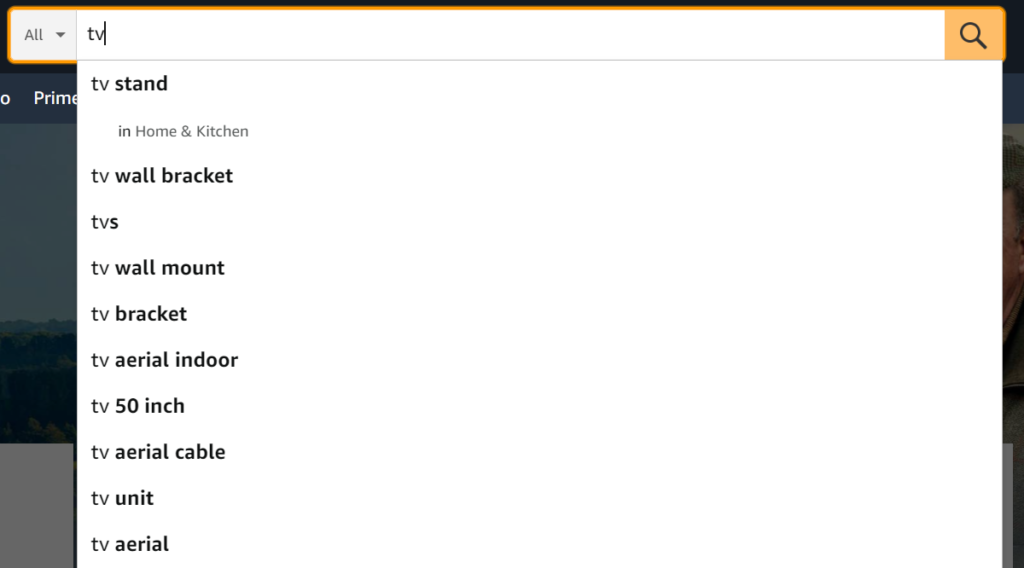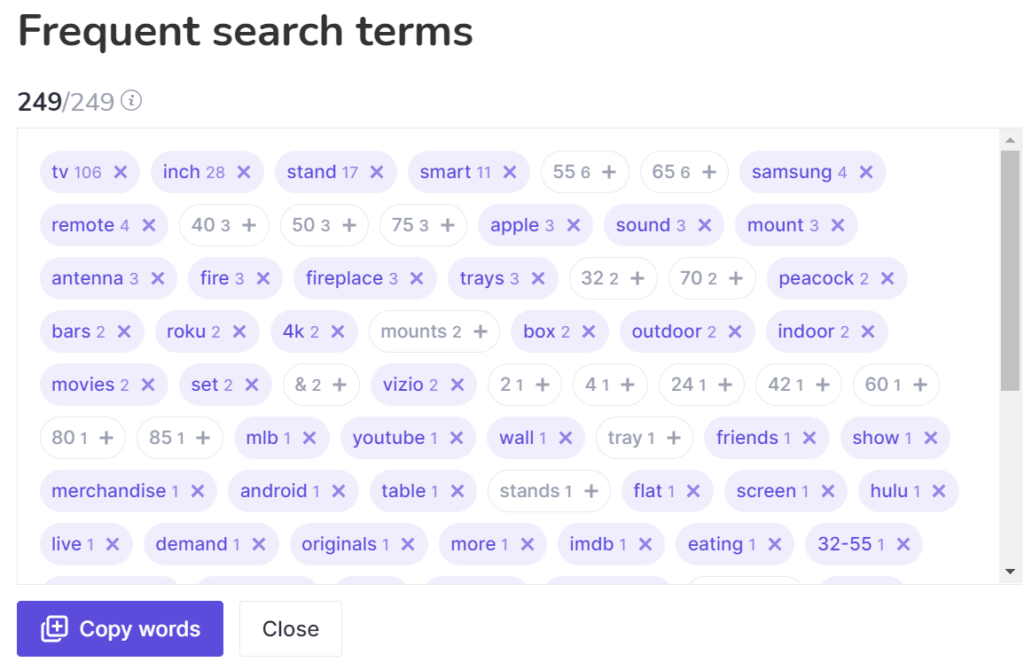Amazon sells over 12 million products, so ensuring your product can be found can be quite a daunting task.
When you consider that there are 1.6 million active sellers and on average 355,000 new sellers join Amazon every year, the idea of being found amongst these looks near impossible.
However, with the right keyword research, an understanding of which product fields are most important and a plan to continuously improve your keywords can put you ahead of the rest.
Amazon’s Search Algorithm
Before we get into the technicalities of keyword research, let's get an understanding of how Amazon’s search algorithm works.
The moniker for their algorithm is A9. Jeff Bezos regularly mentions how he wants Amazon to be the most customer-focussed company on the planet and the Amazon search bar helps achieve this.
When a potential customer enters a keyword into the box here are the four main factors that determine which products show:
- Cart – products that have been added to the cart more frequently are prioritised
- Reviews – items that have positive ratings are more likely to be shown
- Conversion Rate – Amazon looks at how well a product has converted compared to how many page views it has had
- Relevance – a crawler will look at the title, image, keywords and product description on your page and then will rank your product accordingly
If you have just started selling then the first three on this list can be tricky. However, the relevance point is where we can see some big wins.
Amazon SEO
That is where SEO is very important, if you get your keywords optimised then the other three elements will follow.
Just look at Amazon SEO like this:
- Keyword Research
- Optimised Product Listing
- Improve Rankings
- Better Visibility
- More Revenue
The principle of Amazon SEO is exactly the same as ranking in Google. If you’re on page 2 or 3 then you can forget getting any sales.
When you consider that 2 out of 3 people conduct their search for an Amazon product via the search bar then it shows how important SEO is.
Which Amazon Product fields are most important?
Before we get to keyword research let’s dive into what fields we will be conducting the keyword research for and a few tips to make sure you nail it.
Product Title
- Contain important information including benefits and any unique selling points
- 80 characters areideal. Amazon rewards titles that are concise
- If longer, make sure the first 70 characters are the most important as this is the cut off for mobile
- Don’t be subjective. Avoid vague statements such as “Popular” or “Best Seller”

Read more about product titles for Amazon.
Bullet Points
- Highlight the top 5 features, including any specifications and warranty information
- Only 3 bullet points will show on mobile, so make these the best ones
- 200 characters are ideal for each bullet

Read more about bullet points for Amazon.
Production Description
This should complement the bullet points above and will show in the same place. It’s important to remember:
- Not duplicate the bullet points
- Tell a story about your product
Read more about product descriptions for Amazon.
How to do keyword research for Amazon
Now down to business, which are the best ways to conduct keyword research for your products? Below we have listed 5 simple methods to get your products shown.
Autocomplete
Yes, there are plenty of great Amazon keyword tools, of which we’ll mention one later, but you can’t beat the Amazon search bar to get you started.
Just type your seed keyword into the search bar. From here you will receive the most popular keywords related to that. Open a spreadsheet and make a note of these.

Competitors
Are your competitors on Amazon? If you’re unsure just type their name into the search bar and you can then check out their seller account.
Check out the following on their page:
- What keywords are they using?
- Which products have the best reviews?
- Do they have an ASIN?
If there is an ASIN number for the product and you sell the same one. Enter the number into the search bar and see what keywords others are using for it.

Compliments
Another great free way to conduct keyword research is to check the following titles on a product page:
- Frequently bought together
- Products related to this item
- Compare with similar items
Frequently bought together is a great place to start. Check which products Amazon suggests and use the keywords of those products in the bullets of your main products description.

Reviews
Check out your reviews and those of your competitors. Are there any keywords that they use to refer to the product you are selling?
Take this example for a Smart TV. One of the highest-rated reviews mentions several apps and devices that work with the TV. Work these into your product descriptions as they are clearly important.

As mentioned earlier, there are many keyword research tools that you can pay for to help with Amazon. One that we highly recommend is Sellzone.
Sellzone is powered by Semrush who has 12 years of experience in keyword research, so you already know you’re in good hands.
In a nutshell, Sellzone allows you to:
- Identify the most popular keywords for your product on Amazon
- Find easy wins and gaps in keywords to quickly win search visibility
- Strategise and collate all your keywords
This is all possible through Sellzone’s Amazon Keyword Wizard. First off you enter your seed keyword and Sellzone will return phrases based on their volume and the amount of competition for it.

From here you can select whether you want to see a broad, phrase or exact match.
- Broad – this is the widest range possible and can take your keywords and place them in any order
- Phrase – shows exactly the words you entered by in any order
- Exact – keywords have to be in the exact order that you entered them
As mentioned earlier the biggest benefit of Sellzone is that you can identify “low hanging fruit”. This means high volume keywords with low competition.
Using the filters you can adjust the levels and then export the keyword list to use in Amazon.
You can further exclude keywords, let’s say your coffee maker wasn’t small you could remove all mentions of “mini” or “miniature”.

After you have done this, there is also some additional functionality to show the most frequent search teams that appear.
In Amazon when listing a product you have the option to add “Search Terms” which are hidden from your product page. So what you will want to do is remove all the filters on your list and select the “Search Terms” button.
You will then be presented with the most used terms. Sellzone will automatically cap it at 249 characters as per Amazon’s guidelines. It will also remove any instances of numbers as this doesn’t pass Amazon guidelines, as well as singular/plural forms of words already used in another form, stop words, subjective and temporary words, special symbols, etc. Summarizing, everything that Amazon would count as superfluous.

This is really useful from Sellzone, as not only are you getting the most searched for terms related to your product, but you’re removing so much admin time.
In order to use the filters and to export the keywords you need to be on a paid plan which starts at $50 a month.
There is a free plan available which offers the following:
- Split Testing – unlimited use to A/B test titles, product descriptions, images and price points
- Keyword Wizard – 100 keywords total and up to 3 seed keywords per day
- Traffic Insights – unlimited overview reports on competitor tactics. Also gain insight in to which external traffic channels could be most profitable
- Listing Quality Check – fix content errors and incomplete listings. Check all your products abide to Amazon’s guidelines to avoid suspension
If you want to trial the paid plan there is a 7-day free trial, be aware that all results are for the US Amazon Marketplace only at this point.
How to continuously improve your Amazon keywords
Once you have done all the above, you may think that you can now just sit back and watch the sales flood in.
Keyword research isn’t a one off job and you need to be continuously monitoring their performance.
Sellzone’s Listing Protection can help with this. You will be sent an SMS or email if there is an issue with your listing to minimise any losses in sales.
Your products will be monitored 24/7, this includes the effectiveness of your keywords and any adjustments in your search visibility.

Amazon PPC
If you have any additional budget for advertising, it’s worth considering Amazon PPC as this can help your keyword research and in turn boost your SEO.
Also SEO and benefit PPC, if you follow all the instructions highlighted above then you your product pages are correctly optimised. Which means your PPC campaigns will rank well, as they are placed based on relevance.
6 key points for your keywords
When conducting your research it’s worth noting what Amazon doesn’t allow, or doesn’t like.
- Repetition – this isn’t the early 00’s and the old black hat SEO tactic of repeating your most keyword isn’t going to help
- Capitals – capitalising letters, or not, will have no impact on the success of your keywords
- Singular or plural – you don’t need to add both e.g “TV” and “TVs” isn’t necessary. Amazon will show your product for both
- Misspellings – a tactic used in Google ads is to bid on slight misspellings of words, this means they are have a cheap CPC and a high intent. Amazon matches misspellings so to the right spelling so this tactic is fruitless
- Accents/Umlaute – ü will be matchd to ue, so there is no need to add both
- Compound words – if there are spaces in words then you will need to include them with and without. For example you would need to add foot ball and football
Conclusion
If you’re just starting up with Amazon then relevance is absolutely critical for your product listings. You can’t yet rely on add to carts, reviews or conversion rates, so optimisng your pages is vital.
As we’ve established there are a number of free ways to achieve this via the search bar and by checking competitor activity. However if you want to take your keyword research to the next level, by identifying low hanging fruit and carrying out continuous improvement then you shouldn’t look further than a third-party tool such as Sellzone.




Is sellzone specifically built for Amazon? Or can it be used for generally e-commerce keywords research?
Hey Jane,
It’s built for Amazon only. You can use Semrush for keyword research.